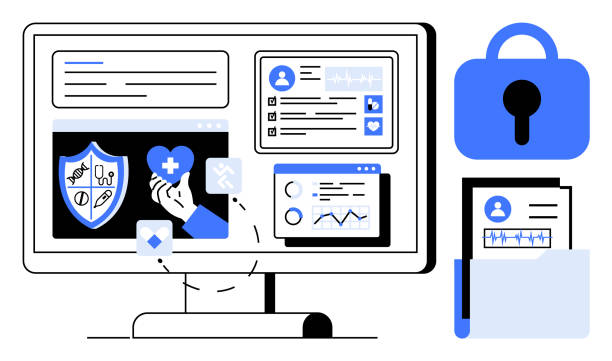Behavioral health professionals—therapists, counselors, and psychiatrists—are increasingly relying on Electronic Health Record (EHR) systems to manage client care, streamline operations, and ensure compliance. As technology evolves, so do EHRs, with new trends emerging that promise to enhance the way mental health care is delivered. The future of EHR in behavioral health: Trends to watch highlights the innovations shaping this field, from artificial intelligence to telehealth integration, offering a glimpse into how these systems will support better outcomes and efficiency. In this guide from Mental Health IT Solutions (MHIS), We’ll explore the key trends to watch, helping you stay ahead in a rapidly changing landscape.
Understanding the Role of EHRs in Behavioral Health
EHRs have already transformed behavioral health by digitizing client records, improving accessibility, and supporting data-driven care. However, the future holds even more potential as new technologies and approaches emerge to address the unique needs of mental health professionals.
The Current State of EHRs in Behavioral Health
Adoption and Impact
EHR adoption in behavioral health has grown significantly, with systems like SimplePractice, TherapyNotes, and Valant offering features tailored to mental health, such as customizable templates and secure teletherapy. These tools have improved documentation, compliance, and client engagement, setting the stage for further innovation.
Challenges to Address
Despite their benefits, EHRs in behavioral health face challenges like interoperability issues, high costs, and the need for better user interfaces. Future trends aim to tackle these pain points, making EHRs more effective and accessible for mental health practices.
Why Trends Matter for Behavioral Health
Evolving Client Needs
Clients increasingly expect digital solutions, such as teletherapy and self-monitoring tools, which EHRs must adapt to support. Staying ahead of trends ensures you can meet these expectations and deliver modern, client-centered care.
Improving Outcomes and Efficiency
Emerging trends in EHR technology promise to enhance clinical decision-making, streamline workflows, and improve therapy outcomes, making them a critical focus for behavioral health professionals looking to the future.
Key Trends Shaping the Future of EHR in Behavioral Health
Let’s explore the top trends that are set to redefine how EHRs support behavioral health practices, focusing on their potential impact and implementation.
1. Integration of Artificial Intelligence (AI) and Machine Learning
Predictive Analytics for Better Outcomes
AI and machine learning are being integrated into EHRs to analyze client data and predict outcomes. For example, an EHR might use historical data to identify clients at risk of relapse or crisis, allowing therapists to intervene proactively. Systems like Valant are beginning to explore these capabilities, offering insights that enhance clinical decision-making.
Automating Administrative Tasks
AI can automate repetitive tasks like transcription of session notes or flagging incomplete documentation, saving therapists time. This trend is a key part of the future of EHR in behavioral health: trends to watch, as it allows clinicians to focus more on client care and less on paperwork.
2. Enhanced Telehealth and Virtual Care Integration
Seamless Teletherapy Features
Telehealth has become a cornerstone of behavioral health, and future EHRs will offer even deeper integration. Systems like TheraPlatform already provide HIPAA-compliant teletherapy, but upcoming advancements will include features like AI-driven session summaries or real-time mood tracking during virtual sessions, improving the quality of remote care.
Virtual Reality (VR) and Augmented Reality (AR) Support
Some EHRs are beginning to explore integration with VR and AR for therapeutic interventions, such as exposure therapy for anxiety. While still in early stages, this trend could allow therapists to conduct immersive sessions directly through the EHR, enhancing treatment options and outcomes.
3. Improved Interoperability and Data Sharing
Seamless Care Coordination
Interoperability—the ability of EHRs to share data with other systems—is a major focus for the future. Behavioral health often involves collaboration with primary care providers, psychiatrists, or social workers, and interoperable EHRs will enable secure, real-time data sharing. Standards like FHIR (Fast Healthcare Interoperability Resources) are driving this trend, ensuring better care coordination.
Integration with Wearables and Apps
Future EHRs will integrate with wearables (e.g., smartwatches) and mental health apps to collect real-time data on clients’ sleep, activity, or mood. For example, a client’s Fitbit data could sync with an EHR like SimplePractice, providing therapists with additional insights to inform treatment plans, a significant trend in the future of EHR in behavioral health: trends to watch.
4. Focus on Client-Centered Features and Engagement
Advanced Client Portals
EHRs are evolving to offer more robust client portals, where clients can access their treatment plans, complete assessments, or engage in self-guided interventions. Future portals might include gamified elements or AI-driven chatbots to support clients between sessions, enhancing engagement and adherence to therapy.
Personalized Treatment Plans
Using AI and data analytics, EHRs will generate more personalized treatment plans based on a client’s history, preferences, and progress. For example, an EHR might recommend specific interventions for a client with PTSD based on their response to past treatments, improving outcomes and client satisfaction.
5. Enhanced Data Security and Privacy Features
Advanced Encryption and Blockchain
As cyber threats grow, future EHRs will adopt advanced security measures like blockchain technology to ensure data integrity and prevent unauthorized access. Blockchain can create a tamper-proof record of data access, enhancing trust and compliance with HIPAA.
Proactive Threat Detection
EHRs will increasingly use AI to detect potential security threats in real-time, such as unusual login patterns that might indicate a breach. This focus on security is crucial for behavioral health, where data sensitivity is high, and aligns with the future of EHR in behavioral health: trends to watch. For more on securing data, see this guide on How to Secure Patient Data with an EHR for Mental Health Practices.
6. Adoption of Voice Recognition and Natural Language Processing (NLP)
Hands-Free Documentation
Voice recognition and NLP are being integrated into EHRs to allow therapists to dictate notes during or after sessions, which the system transcribes and organizes automatically. For example, ICANotes already offers voice-to-text features, but future advancements will improve accuracy and context understanding, reducing documentation time.
Sentiment Analysis for Insights
NLP can analyze the tone and sentiment of client communications, such as messages sent through a client portal, to provide therapists with insights into a client’s emotional state. This can help identify clients who may need urgent support, enhancing the therapeutic process.
7. Cloud-Based Solutions and Scalability
Universal Access and Flexibility
Cloud-based EHRs will continue to dominate, offering universal access, automatic updates, and scalability. Future systems will be even more flexible, allowing practices to add features like AI analytics or VR therapy as needed, without requiring significant infrastructure changes.
Cost-Effective Growth
Cloud solutions reduce the need for on-premise hardware, making them cost-effective for growing practices. This trend supports scalability, ensuring EHRs can adapt to the evolving needs of behavioral health practices. For more on cloud benefits, see this guide on How Cloud-Based EHR Systems Benefit Mental Health Clinics.
Benefits of These Trends for Behavioral Health Practices
Improved Client Outcomes
AI-driven insights, personalized treatment plans, and enhanced telehealth features will lead to more effective interventions, improving client outcomes and satisfaction.
Increased Efficiency
Automation, voice recognition, and interoperability will streamline workflows, allowing therapists to spend more time on client care and less on administrative tasks.
Enhanced Security
Advanced security features like blockchain and proactive threat detection will protect sensitive client data, ensuring compliance and building trust.
Better Client Engagement
Client-centered features, such as advanced portals and wearable integration, will keep clients engaged in their care, leading to better adherence and progress.
Challenges to Consider with Emerging EHR Trends
Cost of Adoption
New features like AI or VR integration may increase subscription costs, so practices will need to balance these expenses with the benefits they provide.
Learning Curve
Advanced technologies like NLP or blockchain may require additional training for therapists and staff to use effectively, potentially slowing adoption.
Regulatory Compliance
As EHRs evolve, they must continue to meet HIPAA and other regulatory requirements, especially with new features like wearable integration or AI analytics.
How to Prepare for the Future of EHR in Behavioral Health
Stay Informed on Trends
Follow industry news and attend conferences to stay updated on EHR advancements, ensuring you’re aware of new features that could benefit your practice.
Choose a Flexible EHR
Select an EHR that can adapt to future trends, such as SimplePractice or TheraNest, which regularly update their platforms with new capabilities. For more on choosing an EHR, see this guide on Choosing the Best EHR for Your Therapy Practice: A Complete Guide.
Invest in Training
Prepare your team for new technologies by investing in training, ensuring they can use advanced features effectively and securely.
The Long-Term Impact on Behavioral Health Practices
Embracing the future of EHR in behavioral health: Trends to watch can position your practice for success in a digital age. By adopting emerging technologies, you can deliver more personalized, efficient, and secure care, leading to better client outcomes and a stronger practice. Staying ahead of these trends ensures that you remain competitive and client-focused in an evolving field.







